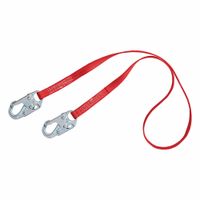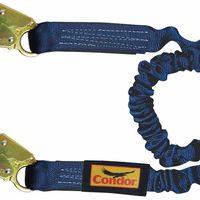Call +(254) 703 030 000 / 751 483 999 / 721 704 777
- Home
- Safety
- Fall Protection
- Self Retracting Lifelines Fall Protection Lanyards
.....Read More
Frequently Asked Questions
What is the difference between a self-retracting lifeline (SRL) and a shock-absorbing lanyard?
A self-retracting lifeline (SRL) and a shock-absorbing lanyard are both fall protection devices used in various industries, but they differ in design, function, and application.
An SRL is a device that automatically retracts and extends a lifeline, allowing the user to move freely within a certain area. It functions like a seatbelt, locking and stopping a fall when a sudden force is applied. SRLs are typically housed in a casing and can be mounted overhead or worn on a harness. They provide a quick arrest of a fall, minimizing the fall distance, which is crucial in areas with limited fall clearance. SRLs are ideal for environments where workers need to move vertically or horizontally over a wide range.
In contrast, a shock-absorbing lanyard is a fixed-length strap, usually made of webbing or cable, with an integrated energy absorber. This absorber reduces the force exerted on the body during a fall by extending and dissipating energy. Shock-absorbing lanyards are generally used in situations where there is sufficient fall clearance, as they require more space to deploy and arrest a fall safely. They are often used in construction or maintenance work where the worker is anchored at a fixed point.
In summary, the primary difference lies in their mechanism and application: SRLs offer automatic retraction and are suitable for limited clearance areas, while shock-absorbing lanyards provide energy absorption and are used where more fall distance is available.
How do you properly inspect a self-retracting lanyard?
To properly inspect a self-retracting lanyard, follow these steps:
1. **Visual Inspection**: Check the entire length of the lanyard for cuts, frays, burns, or other damage. Inspect the housing for cracks or deformities.
2. **Label Check**: Ensure the labels are legible and contain the necessary information, such as the manufacturer's details, model number, and inspection date.
3. **Connectors**: Examine the snap hooks or carabiners for signs of wear, corrosion, or deformation. Ensure the gates open and close smoothly and lock securely.
4. **Lifeline**: Pull the lifeline out completely and inspect for any damage. Look for kinks, knots, or broken fibers. The lifeline should retract smoothly without hesitation.
5. **Braking Mechanism**: Test the braking mechanism by pulling the lifeline sharply to ensure it locks immediately. Release it to check if it retracts smoothly.
6. **Anchorage Point**: Verify that the anchorage point is secure and capable of supporting the intended load.
7. **Functionality Test**: Conduct a functionality test by attaching the lanyard to a secure anchor point and applying a quick, sharp pull to ensure the locking mechanism engages.
8. **Cleaning**: If necessary, clean the lanyard according to the manufacturer's instructions, avoiding harsh chemicals that could damage the material.
9. **Record Keeping**: Document the inspection date, findings, and any actions taken. Maintain records for future reference.
10. **Manufacturer's Guidelines**: Always refer to the manufacturer's instructions for specific inspection criteria and maintenance procedures.
If any defects or issues are found, remove the lanyard from service immediately and consult the manufacturer or a qualified professional for repair or replacement. Regular inspections are crucial for ensuring the safety and reliability of self-retracting lanyards.
What are the OSHA requirements for using self-retracting lifelines?
OSHA requirements for using self-retracting lifelines (SRLs) are primarily outlined in the standards for fall protection, specifically under 29 CFR 1926.502 and 29 CFR 1910.140. Key requirements include:
1. **Design and Performance**: SRLs must be designed to limit the maximum arresting force on a worker to 1,800 pounds when used with a body harness. They should be capable of stopping a fall within 3.5 feet.
2. **Inspection and Maintenance**: SRLs must be inspected before each use for damage, wear, or malfunction. A competent person should conduct regular inspections and maintenance according to the manufacturer’s instructions.
3. **Anchorage**: The anchorage point for SRLs must be capable of supporting at least 5,000 pounds per employee attached or be part of a complete personal fall arrest system that maintains a safety factor of at least two.
4. **Training**: Employers must provide training to workers on the proper use, inspection, and maintenance of SRLs. Workers should understand how to correctly attach the SRL and recognize potential hazards.
5. **Compatibility**: SRLs must be compatible with other components of the fall arrest system to prevent accidental disengagement or failure.
6. **Use Conditions**: SRLs should be used in conditions for which they are designed, such as specific temperature ranges, chemical exposures, or environmental conditions.
7. **Rescue Plan**: Employers must have a rescue plan in place to promptly retrieve workers in the event of a fall.
8. **Labeling and Instructions**: SRLs must have clear labeling and instructions provided by the manufacturer, including limitations and proper usage guidelines.
These requirements ensure that SRLs are used safely and effectively to protect workers from fall hazards.
How do you determine the correct length of a fall protection lanyard?
To determine the correct length of a fall protection lanyard, consider the following factors:
1. **Free Fall Distance**: The lanyard should limit the free fall distance to a maximum of 6 feet (1.8 meters) as per OSHA standards. Measure the distance from the anchorage point to the worker's harness attachment point to ensure compliance.
2. **Total Fall Distance**: Calculate the total fall distance, which includes the free fall distance, deceleration distance (typically 3.5 feet or 1.1 meters for shock-absorbing lanyards), and the height of the worker. Ensure the total fall distance does not exceed the available clearance below the work area.
3. **Anchorage Point**: The height and location of the anchorage point affect the lanyard length. A higher anchorage point may require a shorter lanyard to minimize free fall distance.
4. **Work Area Clearance**: Assess the clearance below the work area to ensure there is enough space to arrest a fall safely without the worker hitting the ground or any lower-level obstacles.
5. **Type of Lanyard**: Choose between a fixed-length lanyard or an adjustable one. Shock-absorbing lanyards are preferred as they reduce the impact force on the worker.
6. **Work Task and Mobility**: Consider the worker's need for mobility. The lanyard should be long enough to allow necessary movement but not so long that it increases the risk of a fall.
7. **Regulatory Compliance**: Ensure the lanyard meets relevant safety standards and regulations, such as OSHA, ANSI, or CSA, depending on the location.
By evaluating these factors, you can select a lanyard that provides adequate fall protection while allowing for safe and efficient work performance.
Can self-retracting lifelines be used horizontally?
Yes, self-retracting lifelines (SRLs) can be used horizontally, but there are specific considerations and requirements to ensure safety and compliance with regulations. When used horizontally, SRLs must be designed and rated for such applications, as horizontal use introduces different forces and potential hazards compared to vertical use.
1. **Manufacturer's Specifications**: Always refer to the manufacturer's instructions and specifications. The SRL must be explicitly rated for horizontal use, as not all SRLs are designed for this purpose.
2. **Leading Edge Applications**: When used horizontally, SRLs often encounter leading edge situations where the lifeline may come into contact with a sharp edge during a fall. SRLs used in these scenarios must be rated for leading edge use, often denoted as "LE" models, and have a reinforced cable or webbing to withstand the additional abrasion and potential cutting forces.
3. **Anchor Point**: The anchor point for horizontal use must be properly positioned and capable of withstanding the forces generated during a fall. It should be at or above the dorsal D-ring height of the harness to minimize free fall distance and swing fall hazards.
4. **Clearance Requirements**: Ensure there is adequate clearance below the work area to prevent the worker from striking the ground or other obstacles in the event of a fall. Horizontal use may require more clearance than vertical use due to potential swing falls.
5. **Training and Inspection**: Workers must be trained in the proper use of SRLs in horizontal applications. Regular inspection and maintenance of the SRL are crucial to ensure its integrity and functionality.
By adhering to these guidelines and ensuring the SRL is suitable for horizontal use, workers can safely utilize these devices in various work environments.
What is the maximum arresting force allowed for fall protection lanyards?
The maximum arresting force allowed for fall protection lanyards is 1,800 pounds (8 kN) for a full-body harness according to OSHA standards.
How often should fall protection equipment be inspected and maintained?
Fall protection equipment should be inspected before each use and undergo a more thorough inspection at least once a year by a competent person. Pre-use inspections are crucial for identifying any visible damage or wear that could compromise safety. These inspections should include checking for cuts, frays, abrasions, or other signs of wear on harnesses, lanyards, and lifelines. Hardware components like buckles, D-rings, and snap hooks should be checked for deformation, corrosion, or malfunction.
Annual inspections are more detailed and should be conducted by someone with the expertise to identify less obvious issues. This inspection should include a comprehensive examination of all components, including stitching, labels, and any mechanical parts. The inspector should also verify that the equipment complies with current safety standards and manufacturer guidelines.
In addition to regular inspections, fall protection equipment should be maintained according to the manufacturer's instructions. This includes proper cleaning, storage, and handling to prevent damage. Equipment should be stored in a cool, dry place away from direct sunlight and chemicals that could degrade materials.
If any equipment is found to be defective or damaged during inspections, it should be removed from service immediately and either repaired by a qualified professional or replaced. Keeping detailed records of inspections and maintenance activities is also recommended to ensure compliance with safety regulations and to track the equipment's condition over time.


